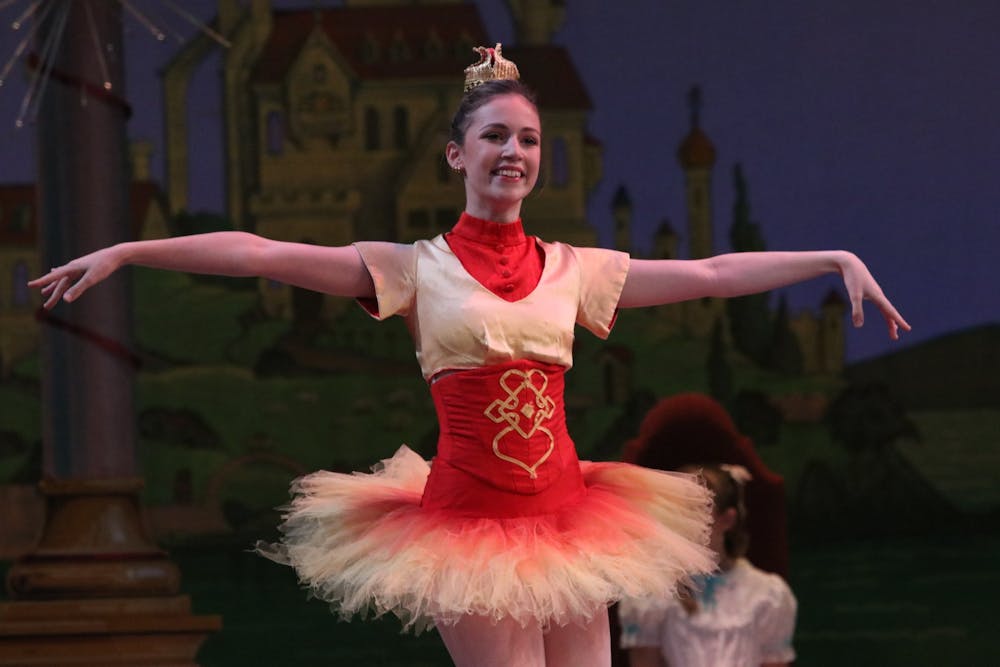For one minute and one second of “The Nutcracker,” flutes soar, pointe shoes crack against gray marley floors and violin strings thrum underneath it all. But these sixty-one seconds — one hundred and thirty-four measures — have launched petitions, enraged viewers and become a point of contention every holiday season.
Since its premiere in Russia in 1892, “The Nutcracker” has featured “Chinese Tea,” a piece that has often leaned on stereotypical depictions of Chinese culture. With many still debating over what’s acceptable, often directors and choreographers must decide for themselves how to approach the issue.
“The Nutcracker is our only stronghold on American holiday culture,” IU’s ballet department chair Sarah Wroth said. “We want to keep it relevant and we want to keep it inclusive of as many fans and believers as we can.”
IU Ballet will present its annual production of “The Nutcracker” this coming weekend at 7:30 p.m. Dec. 2, 3 and 4 and at 2 p.m. Dec. 4 and 5. All showtimes will be streamed at all times on IUMusicLive. This is the last year that the production will use director and choreographer Michael Vernon’s original choreography before it’s completely reworked.
“We’ve had people go through the pre-college program and have grown up with this ballet,” Ruth Connelly, a sophomore ballet major, said. “And, now that they’re starting to trickle out, it’s like, ‘a new generation is coming, so let’s make something new.’”
For one more year, students and faculty are working to make sure every student feels welcome as they dance in IU’s production of the most performed ballet worldwide.
The “Chinese Tea” divertissement — a word for short dance within the larger ballet — doesn’t contain many elements that could be flagged as a caricature. The dancers bow at the waist in the beginning, which is unlike classical ballet, and their hands are flexed, which is a variation on a common gesture where one finger is held up.
Connelly said she feels cultural elements are being erased from the choreography out of fear of falling into caricature, and choreographers are leaning away from portraying any Chinese culture in fear of being called out.
“Our culture has transitioned in such a crazy way from when it was created to now,” Connelly said. “With all the hate crimes and things like that, people are trying to steer clear by not touching it because they’re afraid they’ll be wrong.”
Connelly, who was born in China and adopted into an American family, wanted to follow up on a department meeting at the beginning of the year where faculty had mentioned wanting to discuss diversity issues. They’d said another meeting would occur in a few weeks, but it never happened.
Zoe Gallagher had also been worried. Gallagher is a sophomore ballet student who was cast, among other roles, in the “Chinese Tea” divertissement. After watching past years’ choreography, she said she felt uncomfortable with the idea of dancing it onstage. So she went to Wroth’s office after class the next day.
The choreography has changed from what it was in the video Gallagher had watched. Vernon inherited the production in 2007, including sets and costumes, from previous “Nutcracker” performances when he took over as director. He fit his choreography to what the university already had, Wroth said.
The music and often the choreography used for “Chinese Tea” contains elements of orientalism, Wroth said, and portrays clear cultural themes often passed over when companies are considering rechoreographing. The traditionalist Western lens by which we view these themes can lead to stereotyping, she said.
“We as dancers so often just do,” Wroth said. “We’re doing it for the audience. We’re doing it for the choreographer. We don’t think about why or how as often.”
Wroth said she wanted to make sure students feel they can voice their thoughts and be heard by faculty. So, in response to Connelly’s concern, a conference on portraying diversity began to take shape.
“My main point throughout this entire talk is to make sure there’s a way for them to include diversity without wiping it out and to include the new, evolved ways of diversity,” Connelly said.
And before Gallagher’s first “Chinese Tea” rehearsal began, the professor running the rehearsal sat the dancers down to discuss how to perform the dance sensitively.
“I think that ‘The Nutcracker’ is definitely getting a new look, and I think part of it is just the times we live in,” Vernon said. “I’m really glad that ballet has come into the present.”
“The Nutcracker” has always struggled with cultural portrayals, particularly those affecting the Chinese community. In choreography worldwide, chopsticks stab through ballet buns. Dancers shuffle, rather than walk, onstage. One finger sticks up, or two are held up together. It’s a caricature that, in the past, has come into question, particularly after the post-pandemic rise in anti-Asian sentiment.
IU Ballet has already made several recent changes in order to stay relevant, Wroth said.
Vernon has made slight changes to the piece, but has never made large changes. He maintains that he would have fully rechoreographed the piece a long time ago if he believed it could be considered offensive. Vernon’s original choreography debuted in 2007, nearly 15 years ago.
Often mimicking Chinese traditional dress with silk embroidery and painted makeup, caricatures are common in costuming. IU’s possible changes to “The Nutcracker” have been limited by their budget because the production is set to be reworked.
Many productions’ costumes allude to stereotypical depictions of Chinese people, including references to rice farmer’s or railroad worker’s apparel. IU’s Chinese divertissement features tutus as an attempt to avoid these issues, Vernon said. While the faculty has said the costumes aren’t ideal, Gallagher and Connelly said it’s something that will have to stick around for another year.
“They hear us, and they never make us feel uncomfortable,” Connelly said. “They want to work with us, but we don’t see change happen because it’s just not accessible to them. They can’t just flip a switch.”
Connelly still holds to her concerns about how sometimes, rather than adjusting choreography to celebrate Chinese culture, cultural elements were simply erased. One such moment occurs in “The Nutcracker” finale. The dancers in “Chinese Tea” now stand in a standard ballet position, though the Spanish and Arabian dancers pose in character.
“It’s such a small, little detail that I noticed,” Connelly said. “But to me, I thought, ‘Why did you take out that part, out of all the things?’”
During the 2020-21 school year, the program brought in teachers and lecturers from a variety of backgrounds over Zoom to talk about the future of equitable ballet, Gallagher said. These guest faculty members included directors of primarily Black ballet companies, the artistic director of Boston Ballet and the founders of Final Bow for Yellowface. Final Bow for Yellowface began as a petition started by Georgina Pazcoguin, a former New York City Ballet soloist, and Phil Chan, an arts administrator and educator, who wanted to take a stand against stereotypical depictions of Asians and Asian Americans in ballet.
According to Final Bow’s website, the continued use of traditional depictions of Asian culture prevents Asian American dancers from being seen as nuanced individuals. The website provides educational resources focusing on Asian portrayals in “The Nutcracker”.
While she related to the speakers, Connelly said she felt the faculty used Final Bow to justify a uniform change. Both students both noted the change, from pink ballet tights to skin-colored ones, as drastic and abrupt. The change was eventually dropped.
Nearly every company has its own version of “The Nutcracker” and it’s always recognizable, though the plot may differ slightly. While other shows come and go, “The Nutcracker” is performed every holiday season like clockwork.
“The Nutcracker” is popular, and it sells tickets, according to the New York Times. In a 2017 survey of ballet companies done by Dance/USA, “The Nutcracker” ticket sales represented $51 million, which correlates to 48% of total season revenue. Ticket prices have nearly doubled. The New York City Ballet’s production of “The Nutcracker” attracts over 100 thousand people annually.
It’s shaped American ballet as a whole, according to the Wilson Center. Now, according to the New York Times, “The Nutcracker” is normally the most important ballet companies put on.
This year, IU Ballet is holding a conference within the department after students, such as Connelly, voiced their concerns. She hopes it’ll open a dialogue and she said she wants to make sure it starts real change.
“Once I’m gone in two or three years, no one’s going to say, ‘Oh, let’s call her up!’” Connelly said. “I want to see, once I’m gone, how they’re going to progress.”
Wroth said she had spoken with Sachet Watson, Jacobs’s diversity and inclusion coordinator, about how to implement changes.
After more than 15 years, this is the last year of Vernon’s original production. Next year, IU Ballet associate professor Sasha Janes will take over, completely reworking the storyline, costuming and choreography. It’s unknown exactly how this will affect the “Chinese Tea” dance, but Wroth said Janes is changing the context of the divertissement.
“There’s absolutely ways to recontextualize these ballets where you take the story and change the way it’s been told,” Wroth said. “You preserve the music, and you preserve what’s good, and you shift what doesn’t have a place now.”
A recent New York Times article showcases different ways ballet companies are reworking the controversial section. Though solutions range from a “Green Tea Cricket” to a ribbon dance, the message stays the same: There’s been a shift in what’s acceptable to dance onstage.
“It’s one simple word: respect,” Ma Cong, resident choreographer at Tulsa Ballet, told the Times. “It’s truly important to have respect for all cultures and to be as authentic as possible.”
Across the nation, ballet companies are making changes that encourage diversity. Many companies promote diversity initiatives. Organizations, such as Final Bow for Yellowface and Brown Girls Do Ballet, have garnered widespread support. However, some companies still put performers in blackface for shows such as “La Bayadere” and “Petrushka.”
Connelly said, looking forward, she wants to help the department with their ideas and to make sure they have input from people of color.
“I want to see where they’re at and just let them know where we’re at so we can start to work together because, obviously, they’re the ones in power,” she said. “They have a vision of where they want their department to be.”
Gallagher said “The Nutcracker” will be beautiful not only because it’s been two years since IU has performed it but because it’s Vernon’s retiring performance. She said she’s incredibly thankful to be a part of it.
“Rome wasn’t built in a day — the ballet world won’t change in a day,” Gallagher said. “Right now, it’s about doing the best with what we have and doing the best we can. I think everybody’s committed to doing that.”




